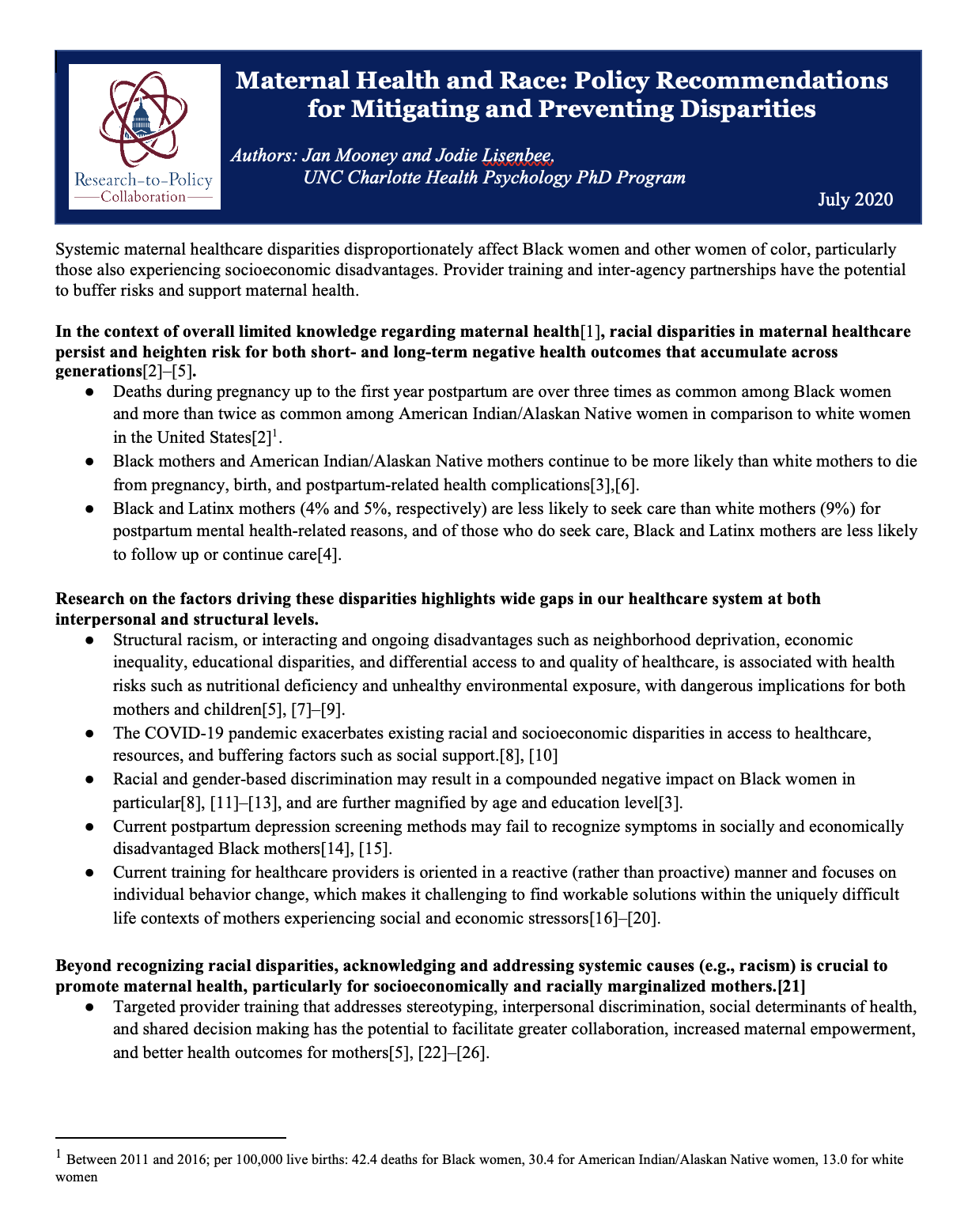
Systemic maternal healthcare disparities disproportionately affect Black women and other women of color, particularly those also experiencing socioeconomic disadvantages. Provider training and inter-agency partnerships have the potential to buffer risks and support maternal health.
In The Context Of Overall Limited Knowledge Regarding Material Health[1], Racial Disparities In Material Healthcare Persist And Heighten Risk For Both Short- And Long-term Negative Health Outcomes That Accumulate Across Generations[2]–[5].
- Deaths during pregnancy up to the first year postpartum are over three times as common among Black women and more than twice as common among American Indian/Alaskan Native women in comparison to white women in the United States [2].
- Black mothers and American Indian/Alaskan Native mothers continue to be more likely than white mothers to die from pregnancy, birth, and postpartum-related health complications [3],[6].
- Black and Latinx mothers (4% and 5%, respectively) are less likely to seek care than white mothers (9%) for postpartum mental health-related reasons, and of those who do seek care, Black and Latinx mothers are less likely to follow up or continue care [4].
Research On The Factors Driving These Disparities Highlights Wide Gaps In Our Healthcare System At Both Interpersonal And Structural Levels.
- Structural racism, or interacting and ongoing disadvantages such as neighborhood deprivation, economic inequality, educational disparities, and differential access to and quality of healthcare, is associated with health risks such as nutritional deficiency and unhealthy environmental exposure, with dangerous implications for both mothers and children [5],[7]–[9].
- The COVID-19 pandemic exacerbates existing racial and socioeconomic disparities in access to healthcare, resources, and buffering factors such as social support. [8],[10]
- Racial and gender-based discrimination may result in a compounded negative impact on Black women in particular [8],[11]–[13], and are further magnified by age and education level [3].
- Current postpartum depression screening methods may fail to recognize symptoms in socially and economically disadvantaged Black mothers [14],[15].
- Current training for healthcare providers is oriented in a reactive (rather than proactive) manner and focuses on individual behavior change, which makes it challenging to find workable solutions within the uniquely difficult life contexts of mothers experiencing social and economic stressors [16]–[20].
Targeted Provider Training That Addresses Stereotyping, Interpersonal Discrimination, Social Determinants Of Health, And Shared Decision Making Has The Potential To Facilitate Greater Collaboration, Increased Maternal Empowerment, And Better Health Outcomes For Mothers [5],[22]–[26].
- Beyond recognizing racial disparities, acknowledging and addressing systemic causes (e.g., racism) is crucial to promote maternal health, particularly for socioeconomically and racially marginalized mothers. [21]
- Funds could be allocated to develop and maintain clinical-community partnerships to improve access to resources for broad, long-term maternal health and well-being (e.g., occupational support, housing support, health workers such as doulas, lactation consultants) [3],[4],[22],[27].
- Leverage private industry expertise by supporting community partnerships with healthcare firms that already provide services such as telehealth, health education resources, personalized treatment, and interdisciplinary provider networks, to improve quality of and access to maternal healthcare [28].
- Between 2011 and 2016; per 100,000 live births: 42.4 deaths for Black women, 30.4 for American Indian/Alaskan Native women, 13.0 for white women.
End Notes / References
[1] M. Dusenbery, Doing Harm: The Truth about how Bad Medicine and Lazy Science Leave Women Dismissed, Misdiagnosed, and Sick. HarperOne, 2018.
[2] CDC, “Pregnancy mortality surveillance system: Maternal and infant health,” Feb. 04, 2020. https://www.cdc.gov/reproductivehealth/maternal-mortality/pregnancy-mortality-surveillance-system.htm (accessed Jul. 16, 2020).
[3] E. E. Petersen et al., “Racial/ethnic disparities in pregnancy-related deaths – United States, 2007-2016,” MMWR Morb Mortal Wkly Rep, vol. 68, no. 35, pp. 762–765, Sep. 2019, doi:10.15585/mmwr.mm6835a3.
[4] K. B. Kozhimannil, C. M. Trinacty, A. B. Busch, H. A. Huskamp, and A. S. Adams, “Racial and ethnic disparities in postpartum depression care among low-income women,” Psychiatr. Serv., vol. 62, no. 6, pp. 619–625, 2011.
[5] A. F. Beck, E. M. Edwards, J. D. Horbar, E. A. Howell, M. C. McCormick, and D. M. Pursley, “The color of health: how racism, segregation, and inequality affect the health and well-being of preterm infants and their families,” Pediatr. Res., pp. 1–8, 2019.
[6] M. J. Tucker, C. J. Berg, W. M. Callaghan, and J. Hsia, “The Black-White disparity in pregnancy-related mortality from 5 conditions: differences in prevalence and case-fatality rates,” Am J Public Health, vol. 97, no. 2, pp. 247–51, Feb. 2007, doi: 10.2105/AJPH.2005.072975.
[7] J. C. Phelan and B. G. Link, “Is Racism a Fundamental Cause of Inequalities in Health?,” Annu. Rev. Sociol., vol. 41, no. 1, pp. 311–330, 2015, doi: 10.1146/annurev-soc-073014-112305.
[8] K. E. Pickett, J. W. Collins, C. M. Masi, and R. G. Wilkinson, “The effects of racial density and income incongruity on pregnancy outcomes,” Soc. Sci. Med., vol. 60, no. 10, pp. 2229–2238, May 2005, doi:10.1016/j.socscimed.2004.10.023.
[9] D. Goyal, C. Gay, and K. A. Lee, “How much does low socioeconomic status increase the risk of prenatal and postpartum depressive symptoms in first-time mothers?,” Womens Health Issues, vol. 20, no. 2, pp. 96–104, 2010.
[10] M. Webb Hooper, A. M. Napoles, and E. J. Perez-Stable, “COVID-19 and Racial/Ethnic Disparities,” JAMA, May 2020, doi: 10.1001/jama.2020.8598.
[11] bell hooks, “Selling hot pussy: representations of black female sexuality in the cultural marketplace,” Writ. Body Female Embodiment Fem. Theory, pp. 113–128, 1997.
[12] M. M. Quinlan, B. R. Bates, and J. B. Webb, “Michelle Obama ‘Got Back’:(Re) Defining (Counter) Stereotypes of Black Females,” Women Lang., vol. 35, no. 1, pp. 119–126, 2012.
[13] T. T. Lewis and M. E. Van Dyke, “Discrimination and the health of African Americans: The potential importance of intersectionalities,” Curr. Dir. Psychol. Sci., vol. 27, no. 3, pp. 176–182, 2018.
[14] L. H. Chaudron et al., “Accuracy of depression screening tools for identifying postpartum depression among urban mothers,” Pediatrics, vol. 125, no. 3, pp. e609-17, Mar. 2010, doi: 10.1542/peds.2008-3261.
[15] S. D. Tandon, F. Cluxton-Keller, J. Leis, H. N. Le, and D. F. Perry, “A comparison of three screening tools to identify perinatal depression among low-income African American women,” J Affect Disord, vol. 136, no. 1–2, pp. 155–162, Jan. 2012, doi: 10.1016/j.jad.2011.07.014.
[16] E. A. Duthie, E. M. Drew, and K. E. Flynn, “Patient-provider communication about gestational weight gain among nulliparous women: a qualitative study of the views of obstetricians and first-time pregnant women,” BMC Pregnancy Childbirth, vol. 13, no. 1, p. 231, Dec. 2013, doi: 10.1186/1471-2393-13-231.
[17] N. Heslehurst, J. Newham, G. Maniatopoulos, C. Fleetwood, S. Robalino, and J. Rankin, “Implementation of pregnancy weight management and obesity guidelines: a meta-synthesis of healthcare professionals’ barriers and facilitators using the Theoretical Domains Framework,” Obes Rev, vol. 15, no. 6, pp. 462–86, Jun. 2014, doi: 10.1111/obr.12160.
[18] N. E. Stotland, P. Gilbert, A. Bogetz, C. C. Harper, B. Abrams, and B. Gerbert, “Preventing excessive weight gain in pregnancy: how do prenatal care providers approach counseling?,” J Womens Health Larchmt, vol. 19, no. 4, pp. 807–14, Apr. 2010, doi: 10.1089/jwh.2009.1462.
[19] C. Davis and M. Quinlan, “Communicating stigma and acceptance,” in Storied Health and Illness: Communicating Personal, Cultural, and Political Complexities, J. Yamasaki, P. Geist-Martin, and B. F. Sharf, Eds. Long Grove, IL: Waveland Press, 2016, pp. 181–212.
[20] B. Ehrenreich, “Rituals of humiliation,” in Natural causes: An epidemic of wellness, the certainty of dying, and killing ourselves to live longer, New York, NY: Twelve, 2018, pp. 14–31.
[21] J. M. Louis, M. K. Menard, and R. E. Gee, “Racial and ethnic disparities in maternal morbidity and mortality,” Obstet. Gynecol., vol. 125, no. 3, pp. 690–694, 2015.
[22] A. A. White, Seeing patients: Unconscious bias in health care diagnosis and treatment. Cambridge, MA: Harvard University Press, 2011.
[23] D. W. Sue, “Race talk: the psychology of racial dialogues,” Am Psychol, vol. 68, no. 8, pp. 663–72, Nov. 2013, doi: 10.1037/a0033681.
[24] ACOG Committee on Healthcare for Underserved Women, “ACOG Committee Opinion No. 649: Racial and Ethnic Disparities in Obstetrics and Gynecology,” Obstet Gynecol, vol. 126, no. 6, pp. e130-4, Dec. 2015, doi: 10.1097/AOG.0000000000001213.
[25] A. Young and L. Flower, “Patients as partners, patients as problem-solvers,” Health Commun, vol. 14, no. 1, pp. 69–97, 2002, doi: 10.1207/S15327027HC1401_4.
[26] A. DuPré, Communicating about Health: Current Issues and Perspectives. Oxford University Press, 2014.
[27] S. L. Hans, R. C. Edwards, and Y. Zhang, “Randomized Controlled Trial of Doula-Home-Visiting Services: Impact on Maternal and Infant Health,” Matern. Child Health J., vol. 22, no. 1, pp. 105–113, Oct. 2018, doi: 10.1007/s10995-018-2537-7.
[28] S. Bishop and J. Waring, “Public-Private Partnerships in Health Care,” Oxf. Handb. Health Care Manag. Oxf. Univ. Press Oxf., pp. 459–480, 2016.
The Research-to-Policy Collaboration (RPC) works to bring together research professionals and public officials to support evidence-based policy. Please visit their website to learn more.
Key Information
RPC Website
Research-to-Policy Collaboration
Publication DateJuly 1, 2020
Topic Area(s)Community-Specific, Equity, Health
Resource TypeWritten Briefs
Share This Page
Systemic maternal healthcare disparities disproportionately affect Black women and other women of color, particularly those also experiencing socioeconomic disadvantages. Provider training and inter-agency partnerships have the potential to buffer risks and support maternal health.
In The Context Of Overall Limited Knowledge Regarding Material Health[1], Racial Disparities In Material Healthcare Persist And Heighten Risk For Both Short- And Long-term Negative Health Outcomes That Accumulate Across Generations[2]–[5].
- Deaths during pregnancy up to the first year postpartum are over three times as common among Black women and more than twice as common among American Indian/Alaskan Native women in comparison to white women in the United States [2].
- Black mothers and American Indian/Alaskan Native mothers continue to be more likely than white mothers to die from pregnancy, birth, and postpartum-related health complications [3],[6].
- Black and Latinx mothers (4% and 5%, respectively) are less likely to seek care than white mothers (9%) for postpartum mental health-related reasons, and of those who do seek care, Black and Latinx mothers are less likely to follow up or continue care [4].
Research On The Factors Driving These Disparities Highlights Wide Gaps In Our Healthcare System At Both Interpersonal And Structural Levels.
- Structural racism, or interacting and ongoing disadvantages such as neighborhood deprivation, economic inequality, educational disparities, and differential access to and quality of healthcare, is associated with health risks such as nutritional deficiency and unhealthy environmental exposure, with dangerous implications for both mothers and children [5],[7]–[9].
- The COVID-19 pandemic exacerbates existing racial and socioeconomic disparities in access to healthcare, resources, and buffering factors such as social support. [8],[10]
- Racial and gender-based discrimination may result in a compounded negative impact on Black women in particular [8],[11]–[13], and are further magnified by age and education level [3].
- Current postpartum depression screening methods may fail to recognize symptoms in socially and economically disadvantaged Black mothers [14],[15].
- Current training for healthcare providers is oriented in a reactive (rather than proactive) manner and focuses on individual behavior change, which makes it challenging to find workable solutions within the uniquely difficult life contexts of mothers experiencing social and economic stressors [16]–[20].
Targeted Provider Training That Addresses Stereotyping, Interpersonal Discrimination, Social Determinants Of Health, And Shared Decision Making Has The Potential To Facilitate Greater Collaboration, Increased Maternal Empowerment, And Better Health Outcomes For Mothers [5],[22]–[26].
- Beyond recognizing racial disparities, acknowledging and addressing systemic causes (e.g., racism) is crucial to promote maternal health, particularly for socioeconomically and racially marginalized mothers. [21]
- Funds could be allocated to develop and maintain clinical-community partnerships to improve access to resources for broad, long-term maternal health and well-being (e.g., occupational support, housing support, health workers such as doulas, lactation consultants) [3],[4],[22],[27].
- Leverage private industry expertise by supporting community partnerships with healthcare firms that already provide services such as telehealth, health education resources, personalized treatment, and interdisciplinary provider networks, to improve quality of and access to maternal healthcare [28].
- Between 2011 and 2016; per 100,000 live births: 42.4 deaths for Black women, 30.4 for American Indian/Alaskan Native women, 13.0 for white women.
End Notes / References
[1] M. Dusenbery, Doing Harm: The Truth about how Bad Medicine and Lazy Science Leave Women Dismissed, Misdiagnosed, and Sick. HarperOne, 2018.
[2] CDC, “Pregnancy mortality surveillance system: Maternal and infant health,” Feb. 04, 2020. https://www.cdc.gov/reproductivehealth/maternal-mortality/pregnancy-mortality-surveillance-system.htm (accessed Jul. 16, 2020).
[3] E. E. Petersen et al., “Racial/ethnic disparities in pregnancy-related deaths – United States, 2007-2016,” MMWR Morb Mortal Wkly Rep, vol. 68, no. 35, pp. 762–765, Sep. 2019, doi:10.15585/mmwr.mm6835a3.
[4] K. B. Kozhimannil, C. M. Trinacty, A. B. Busch, H. A. Huskamp, and A. S. Adams, “Racial and ethnic disparities in postpartum depression care among low-income women,” Psychiatr. Serv., vol. 62, no. 6, pp. 619–625, 2011.
[5] A. F. Beck, E. M. Edwards, J. D. Horbar, E. A. Howell, M. C. McCormick, and D. M. Pursley, “The color of health: how racism, segregation, and inequality affect the health and well-being of preterm infants and their families,” Pediatr. Res., pp. 1–8, 2019.
[6] M. J. Tucker, C. J. Berg, W. M. Callaghan, and J. Hsia, “The Black-White disparity in pregnancy-related mortality from 5 conditions: differences in prevalence and case-fatality rates,” Am J Public Health, vol. 97, no. 2, pp. 247–51, Feb. 2007, doi: 10.2105/AJPH.2005.072975.
[7] J. C. Phelan and B. G. Link, “Is Racism a Fundamental Cause of Inequalities in Health?,” Annu. Rev. Sociol., vol. 41, no. 1, pp. 311–330, 2015, doi: 10.1146/annurev-soc-073014-112305.
[8] K. E. Pickett, J. W. Collins, C. M. Masi, and R. G. Wilkinson, “The effects of racial density and income incongruity on pregnancy outcomes,” Soc. Sci. Med., vol. 60, no. 10, pp. 2229–2238, May 2005, doi:10.1016/j.socscimed.2004.10.023.
[9] D. Goyal, C. Gay, and K. A. Lee, “How much does low socioeconomic status increase the risk of prenatal and postpartum depressive symptoms in first-time mothers?,” Womens Health Issues, vol. 20, no. 2, pp. 96–104, 2010.
[10] M. Webb Hooper, A. M. Napoles, and E. J. Perez-Stable, “COVID-19 and Racial/Ethnic Disparities,” JAMA, May 2020, doi: 10.1001/jama.2020.8598.
[11] bell hooks, “Selling hot pussy: representations of black female sexuality in the cultural marketplace,” Writ. Body Female Embodiment Fem. Theory, pp. 113–128, 1997.
[12] M. M. Quinlan, B. R. Bates, and J. B. Webb, “Michelle Obama ‘Got Back’:(Re) Defining (Counter) Stereotypes of Black Females,” Women Lang., vol. 35, no. 1, pp. 119–126, 2012.
[13] T. T. Lewis and M. E. Van Dyke, “Discrimination and the health of African Americans: The potential importance of intersectionalities,” Curr. Dir. Psychol. Sci., vol. 27, no. 3, pp. 176–182, 2018.
[14] L. H. Chaudron et al., “Accuracy of depression screening tools for identifying postpartum depression among urban mothers,” Pediatrics, vol. 125, no. 3, pp. e609-17, Mar. 2010, doi: 10.1542/peds.2008-3261.
[15] S. D. Tandon, F. Cluxton-Keller, J. Leis, H. N. Le, and D. F. Perry, “A comparison of three screening tools to identify perinatal depression among low-income African American women,” J Affect Disord, vol. 136, no. 1–2, pp. 155–162, Jan. 2012, doi: 10.1016/j.jad.2011.07.014.
[16] E. A. Duthie, E. M. Drew, and K. E. Flynn, “Patient-provider communication about gestational weight gain among nulliparous women: a qualitative study of the views of obstetricians and first-time pregnant women,” BMC Pregnancy Childbirth, vol. 13, no. 1, p. 231, Dec. 2013, doi: 10.1186/1471-2393-13-231.
[17] N. Heslehurst, J. Newham, G. Maniatopoulos, C. Fleetwood, S. Robalino, and J. Rankin, “Implementation of pregnancy weight management and obesity guidelines: a meta-synthesis of healthcare professionals’ barriers and facilitators using the Theoretical Domains Framework,” Obes Rev, vol. 15, no. 6, pp. 462–86, Jun. 2014, doi: 10.1111/obr.12160.
[18] N. E. Stotland, P. Gilbert, A. Bogetz, C. C. Harper, B. Abrams, and B. Gerbert, “Preventing excessive weight gain in pregnancy: how do prenatal care providers approach counseling?,” J Womens Health Larchmt, vol. 19, no. 4, pp. 807–14, Apr. 2010, doi: 10.1089/jwh.2009.1462.
[19] C. Davis and M. Quinlan, “Communicating stigma and acceptance,” in Storied Health and Illness: Communicating Personal, Cultural, and Political Complexities, J. Yamasaki, P. Geist-Martin, and B. F. Sharf, Eds. Long Grove, IL: Waveland Press, 2016, pp. 181–212.
[20] B. Ehrenreich, “Rituals of humiliation,” in Natural causes: An epidemic of wellness, the certainty of dying, and killing ourselves to live longer, New York, NY: Twelve, 2018, pp. 14–31.
[21] J. M. Louis, M. K. Menard, and R. E. Gee, “Racial and ethnic disparities in maternal morbidity and mortality,” Obstet. Gynecol., vol. 125, no. 3, pp. 690–694, 2015.
[22] A. A. White, Seeing patients: Unconscious bias in health care diagnosis and treatment. Cambridge, MA: Harvard University Press, 2011.
[23] D. W. Sue, “Race talk: the psychology of racial dialogues,” Am Psychol, vol. 68, no. 8, pp. 663–72, Nov. 2013, doi: 10.1037/a0033681.
[24] ACOG Committee on Healthcare for Underserved Women, “ACOG Committee Opinion No. 649: Racial and Ethnic Disparities in Obstetrics and Gynecology,” Obstet Gynecol, vol. 126, no. 6, pp. e130-4, Dec. 2015, doi: 10.1097/AOG.0000000000001213.
[25] A. Young and L. Flower, “Patients as partners, patients as problem-solvers,” Health Commun, vol. 14, no. 1, pp. 69–97, 2002, doi: 10.1207/S15327027HC1401_4.
[26] A. DuPré, Communicating about Health: Current Issues and Perspectives. Oxford University Press, 2014.
[27] S. L. Hans, R. C. Edwards, and Y. Zhang, “Randomized Controlled Trial of Doula-Home-Visiting Services: Impact on Maternal and Infant Health,” Matern. Child Health J., vol. 22, no. 1, pp. 105–113, Oct. 2018, doi: 10.1007/s10995-018-2537-7.
[28] S. Bishop and J. Waring, “Public-Private Partnerships in Health Care,” Oxf. Handb. Health Care Manag. Oxf. Univ. Press Oxf., pp. 459–480, 2016.
The Research-to-Policy Collaboration (RPC) works to bring together research professionals and public officials to support evidence-based policy. Please visit their website to learn more.

Key Information
RPC Website
Research-to-Policy Collaboration
Publication DateJuly 1, 2020
Topic Area(s)Community-Specific, Equity, Health
Resource TypeWritten Briefs
Share This Page
LET’S STAY IN TOUCH
Join the Evidence-to-Impact Mailing List
Keep up to date with the latest resources, events, and news from the EIC.




